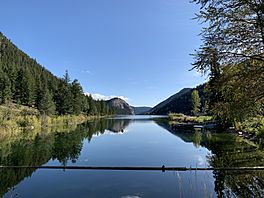Paul Lake Provincial Park facts for kids
Quick facts for kids Paul Lake |
|
|---|---|

Paul Lake Provincial Park
|
|
| Lua error in Module:Location_map at line 420: attempt to index field 'wikibase' (a nil value). | |
| Location | British Columbia |
| Basin countries | Canada |
| Max. length | 6.5 kilometres (4.0 mi) |
| Max. depth | 45 metres (148 ft) |
| Surface elevation | 770 metres (2,530 ft) |
Paul Lake Provincial Park is a beautiful natural area in British Columbia, Canada. It is located southwest of Heffley Lake and northeast of the city of Kamloops. This park is a wonderful spot for outdoor fun and enjoying nature.
Contents
Discover Paul Lake Provincial Park
Paul Lake Provincial Park is a special place in British Columbia. It was created in 1961 to protect the natural beauty around Paul Lake. The park offers many activities for visitors, like fishing, camping, and hiking. It is a popular spot for families and nature lovers.
The Story Behind the Name
The lake and nearby Mount Lolo are thought to be named after a man called Jean Baptiste Lolo. He was also known as St. Paul, or Chief St. Paul. Jean Baptiste Lolo worked as an interpreter at Fort Kamloops. He was from Iroquois and French Canadian backgrounds. The local Secwépemc people respected him and considered him a chief.
Fish and Wildlife in Paul Lake
Paul Lake was originally a lake without fish. However, people later introduced Rainbow trout into the lake. These trout grew very well and made the lake a great place for fishing.
The Introduction of Redside Shiners
Later, another type of fish, called Redside shiners, accidentally got into the lake. These small fish, scientifically known as Richardsonius balteatus, caused some changes. They started to compete with the trout for food, especially tiny creatures called amphipods.
Predator-Prey Relationships
The introduction of the shiners also led to interesting predator-prey interactions. This means how different animals hunt and eat each other. Scientists, like P.A. Larkin and his students, studied these changes in the lake's ecosystem. They learned how the new fish affected the balance of life in Paul Lake.

